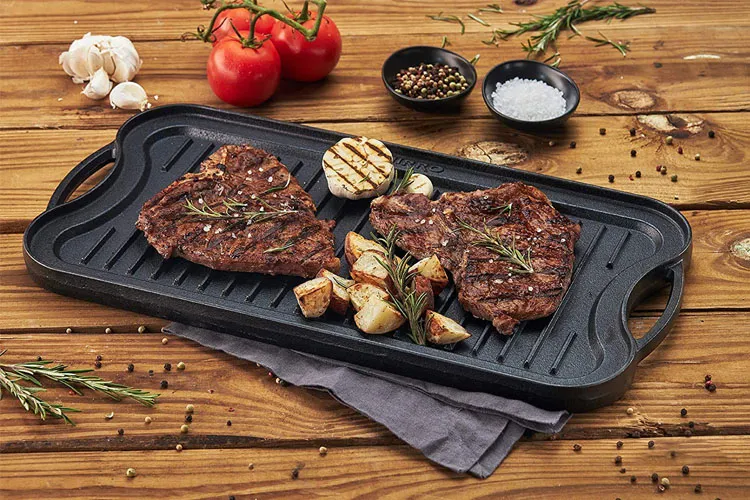
reseasoning a cast iron skillet
Reseasoning a Cast Iron Skillet A Step-by-Step Guide
Cast iron skillets are a beloved staple in many kitchens due to their durability and excellent heat retention. However, over time, they may lose their non-stick properties and develop rust or food buildup. Reseasoning your cast iron skillet not only restores its cooking surface but also enhances its longevity. Here’s a step-by-step guide on how to reseason a cast iron skillet properly.
Why Reseason a Cast Iron Skillet?
The seasoning of a cast iron skillet is a layer of polymerized oil that creates a natural non-stick surface. It protects the skillet from moisture and rust while improving the flavor of your dishes. Factors such as improper cleaning, exposure to water, or using the wrong type of cooking oil can degrade this seasoning. When you notice food sticking or if your skillet has developed an unpleasant odor, it’s time to reseason.
What You’ll Need
To reseason your cast iron skillet, you will need
- A cast iron skillet - Steel wool or a scrub brush - Mild dish soap - A lint-free cloth or paper towels - Cooking oil (flaxseed oil, canola oil, or vegetable oil) - Aluminum foil - An oven
Step-by-Step Reseasoning Process
1. Clean the Skillet Begin by thoroughly cleaning your skillet. Use steel wool or a scrub brush to remove any rust, residue, or old seasoning. This step is crucial, as it lays a clean foundation for the new seasoning. If your skillet is heavily soiled, you might need to use a mild dish soap to aid in cleaning. Rinse it well and dry it completely with a cloth or paper towel.
reseasoning a cast iron skillet

2. Dry the Skillet After rinsing, it’s important to ensure your skillet is completely dry. Cast iron is prone to rust, so place it on the stove over low heat for a few minutes to help evaporate any remaining moisture.
3. Apply Oil Once the skillet is dry, pour a small amount of your chosen cooking oil onto the surface. Using a lint-free cloth or paper towel, rub the oil over the entire surface, including the handle and the outside. Be careful not to use too much oil; a thin, even layer is sufficient. Excess oil can result in a sticky surface.
4. Preheat the Oven While you are applying the oil, preheat your oven to around 450°F (230°C). This high temperature is ideal for polymerizing the oil and creating a solid seasoning layer.
5. Bake the Skillet Place the skillet upside down in the oven. To catch any drips, line the bottom rack with aluminum foil. This will help keep your oven clean while the skillet bakes. Let it bake for about one hour. After an hour, turn off the oven and allow the skillet to cool inside.
6. Repeat if Necessary For best results, you might want to repeat the oil application and baking process 2-3 times. Each layer of seasoning builds a stronger and more durable non-stick surface.
7. Maintenance Once your skillet is reseasoned, maintenance is key to keeping it in good condition. After each use, avoid using soap. Instead, rinse with hot water and scrub with a brush, about 10-15 minutes of soaking if needed. Always dry it thoroughly and apply a thin layer of oil before storing it.
Conclusion
Reseasoning your cast iron skillet is a straightforward process that can bring new life to your trusted cooking companion. With just a few simple steps, you can restore its natural non-stick surface and enjoy the benefits of cooking in a well-seasoned skillet. Just remember that regular care and maintenance will keep your cast iron skillet in great shape, ensuring that it will be part of your kitchen for years to come. Embrace the art of cast iron cooking, and relish the wonderful flavors it brings to your meals!
-
Season Cast Iron Perfectly with GPT-4 Turbo TipsNewsAug.01,2025
-
High Quality Cast Iron Cookware - Baixiang County Zhongda MachineryNewsAug.01,2025
-
Premium Cast Iron Pan: Durable & Perfect HeatNewsAug.01,2025
-
High Quality Kitchen Durable Black Round Cast Iron Cookware Pancake Crepe Pan-Baixiang County Zhongda Machinery Manufacturing Co., Ltd.NewsAug.01,2025
-
Cast Iron Cookware - Baixiang County Zhongda Machinery | Nonstick, Heat ResistanceNewsAug.01,2025
-
High Quality Kitchen Durable Black Round Cast Iron Cookware - Baixiang County Zhongda Machinery | Non-Stick, Heat Retention, DurableNewsJul.31,2025


